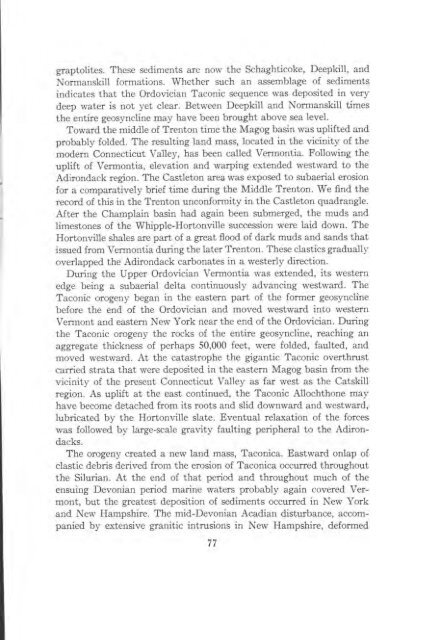STRATIGRAPHY AND STRUCTURE CASTLETON AREA VERMONT
STRATIGRAPHY AND STRUCTURE CASTLETON AREA VERMONT
STRATIGRAPHY AND STRUCTURE CASTLETON AREA VERMONT
Create successful ePaper yourself
Turn your PDF publications into a flip-book with our unique Google optimized e-Paper software.
graptolites. These sediments are now the Schaghticoke, Deepkill, and<br />
Normanskill formations. Whether such an assemblage of sediments<br />
indicates that the Ordovician Taconic sequence was deposited in very<br />
deep water is not yet clear. Between Deepkill and Normanskill times<br />
the entire geosyncline may have been brought above sea level.<br />
Toward the middle of Trenton time the Magog basin was uplifted and<br />
probably folded. The resulting land mass, located in the vicinity of the<br />
modern Connecticut Valley, has been called Vermontia. Following the<br />
uplift of Vermontia, elevation and warping extended westward to the<br />
Adirondack region. The Castleton area was exposed to subaerial erosion<br />
for a comparatively brief time during the Middle Trenton. We find the<br />
record of this in the Trenton unconformity in the Castleton quadrangle.<br />
After the Champlain basin had again been submerged, the muds and<br />
limestones of the Whipple-Hortonville succession were laid down. The<br />
Hortonville shales are part of a great flood of dark muds and sands that<br />
issued from Vermontia during the later Trenton. These elastics gradually<br />
overlapped the Adirondack carbonates in a westerly direction.<br />
During the Upper Ordovician Vermontia was extended, its western<br />
edge being a subaerial delta continuously advancing westward. The<br />
Taconic orogeny began in the eastern part of the former geosyncline<br />
before the end of the Ordovician and moved westward into western<br />
Vermont and eastern New York near the end of the Ordovician. During<br />
the Taconic orogeny the rocks of the entire geosyncline, reaching an<br />
aggregate thickness of perhaps 50,000 feet, were folded, faulted, and<br />
moved westward. At the catastrophe the gigantic Taconic overthrust<br />
carried strata that were deposited in the eastern Magog basin from the<br />
vicinity of the present Connecticut Valley as far west as the Catskill<br />
region. As uplift at the east continued, the Taconic Allochthone may<br />
have become detached from its roots and slid downward and westward,<br />
lubricated by the Hortonville slate. Eventual relaxation of the forces<br />
was followed by large-scale gravity faulting peripheral to the Adirondacks.<br />
The orogeny created a new land mass, Taconica. Eastward onlap of<br />
elastic debris derived from the erosion of Taconica occurred throughout<br />
the Silurian. At the end of that period and throughout much of the<br />
ensuing Devonian period marine waters probably again covered Vermont,<br />
but the greatest deposition of sediments occurred in New York<br />
and New Hampshire. The mid-Devonian Acadian disturbance, accompanied<br />
by extensive granitic intrusions in New Hampshire, deformed<br />
77













